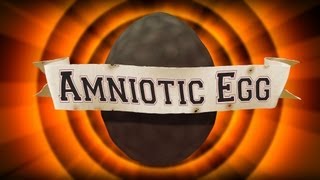(单词翻译:单击)
Would you believe that walruses, rattlesnakes, and parakeets all once lived in the same house?
你相信海象、响尾蛇和鹦鹉曾经在同一个屋檐下居住吗?
Let's go back about 350 million years. Look around.
让我们回到3.5亿年前。观望一下。
Steamy swamps and rain forests of horsetails and ferns cover the region.
潮湿的沼泽,马尾松的热带雨林以及各种蕨类植物覆盖了地面。
Amphibians are the dominant land vertebrates.
两栖动物在陆地上占主导地位。
They range in size from newts to crocodiles.
它们从最小的蝾螈到巨大的鳄鱼。
And all require water to do their egg laying.
但是都需要水来产下他们的卵。
If they don't go to the water, their shell-less, jelly-like eggs will dry out.
如果他们远离水,他们没有外壳、像果冻一样的卵就会变干。
Because of this hazard, they spend most of their time living in or near fresh water.
由于这种危险,他们大部分时间都生活在水中或者附近。
That is, until a breakthrough in evolution changes everything: the amniotic egg.
也就是说,直到一个突破性的进化改变了这一切:羊膜卵。
The amniotic egg is shelled, waterproof, and can be laid on dry land.
羊膜卵有外壳,防水,并且可以孵化在干燥的土地上。
It is produced by the amniotes, a new group of animals named after their revolutionary egg.
羊膜卵是由羊膜动物孵化的,它们革命性的卵创造了一种新的生物种类。
The first amniote is a tetrapod, a four-legged animal, resembling a small lizard.
第一种羊膜动物是四足动物,是一种四条腿的动物,类似小的蜥蜴。
While some amphibians can walk around on land and bury their eggs in wet soil or highly humid areas,
虽然一些两栖动物可以在陆地上行走,并将它们的卵埋在湿土里或极度潮湿的区域,
nothing before the amniotes has the ability to lay its eggs on completely dry land.
但是在羊膜动物之前没有生物有能力在完全干燥的土地上产卵。
Because of this evolved egg, the amniotes are the first animals with the ability to live a fully terrestrial life.
而正是由于这种进化的卵,羊膜动物成为了第一种完全具备陆地生活的能力的动物。
But, despite their move inland, the amniotes have not abandoned their pond-dwelling upbringing.
但是,尽管它们向陆地进军,这些羊膜动物也并没有抛弃它们池塘生活的习性。
In fact, the amniotic egg brings the pond with them by enclosing the aquatic environment within its shell.
事实上,羊膜卵用它们的外壳把池塘的水生环境给包裹了起来。
This is achieved by four main upgrades that are unique to amniotic eggs. Let's take a closer look.
这是通过四个主要的升级而实现的,而这些也是羊膜卵的独特之处。让我们仔细看看。
The first development is the most obvious: the egg's protective shell.
第一个进化是最明显的:卵的保护外壳。
It's tough but flexible, and has a leathery surface, still seen in reptile eggs today.
它坚韧而灵活,还由貌似皮毛状的外表,至今仍然可以在爬行类动物的卵上发现。
The shell protects the eggs from predators, bacteria, damage, and drying out.
外壳保护卵免于捕食者、细菌、冲击和干燥。
But, unlike the walls of a fish tank, the shell of the amniotic egg is porous,
但与鱼缸壁不同的是,羊膜卵的外壳有很多细小的透气孔,
allowing oxygen to pass through so that the growing amniote inside doesn't suffocate.
这样氧气可以透过这些小孔,使发育中的胚胎不会在卵里窒息。
The next two developments are two separate membranes that work together like a pair of lungs.
接下来的两个进化是有两个单独的膜,他们能像肺一样协同工作。

They bring oxygen into the embryo while removing carbon dioxide.
它们把氧气带入胚胎,同时排出二氧化碳。
The first is the chorion, which is the protective layer that oxygen passes through after entering the shell's tiny pores.
第一个是绒毛膜,这是一层保护膜,能令氧气在进入外壳的细小毛孔之后顺利通过。
You may recognize the chorion as the thin skin you peel away on a hard boiled egg.
你可以将绒毛膜看成一个煮鸡蛋剥掉外壳之后剩下的那层薄薄的皮。
Think of this waterproof membrane as the in and out doors of the egg.
可以将这层防水膜想像成一个卵的气体交换的大门。
It's the entrance for oxygen and exit for carbon dioxide.
它是氧气的入口,同时也是二氧化碳的出口。
The membrane working with the chorion is the allantois.
与绒毛膜协同工作的是尿膜。
If the chorion is the doors, then the allantois is essentially the lobby of the building.
如果绒毛膜是门,那么尿膜就是这座建筑的大堂。
It directs the oxygen and carbon dioxide while simultaneously storing unneeded waste from the embryo.
它为氧气和二氧化碳指明方向,同时存储胚胎的产生的废物。
The chorion and the allantois make sure the embryo has everything it needs and gets rid of anything it doesn't.
绒毛膜和尿膜确保胚胎获得一切所需,并且也为其清除一切废物。
The last and perhaps the most important development is the amnion, the membrane for which the egg is named.
最后一个,可能也是最重要的进化,是羊膜,羊膜卵就是以其命名的。
The amnion is also contained within the chroion and holds the fluid in which the embryo floats.
羊膜也包裹在绒毛膜内,使得胚胎能在液态环境中漂浮。
Because it has left the watery world of the amphibians,
因为它已经离开了两栖动物生活的水底世界,
the amnion is necessary for preventing the embryo from drying out.
所以羊膜对防止胚胎干燥是必不可少的保护。
It is the transportable pond that allows the amniote to lay the egg on dry land.
它是一个可移动的池塘,使得羊膜动物可将卵产在干燥的陆地上。
Its fluid also protects the embryo from any collisions or rough landings, like a shock absorber on your bike or car.
它的液体还可以保护胚胎免于碰撞或硬着陆,就像你的自行车或汽车上的减震器。
Together, the shell and these four membranes create a safe, watery environment for the embryo to grow and develop.
外壳和这些膜共同为胚胎的发育和成长创造了一个安全的水生环境。
The new amniote offspring will continue the process of vertebrate evolution as it explores new land away from the water.
新的羊膜动物的后代将继续他们向脊椎动物的进化,离开水域去探索新大陆。
They will spend the next million years splitting into two distinct groups: the synapsids and sauropsids.
它们将用接下来的几百万年分化成两个不同的种群:下孔类和蜥行类。
Synapsida is the group of animals that contain mammals,
下孔类动物包括哺乳类动物,
while sauropsida is the group that contains reptiles, birds, and dinosaurs.
而蜥行类动物包括爬行动物、鸟和恐龙。
These two amniotic groups collectively contain the walruses, rattlesnakes, and parakeets we know today.
这两个羊膜动物的种群包括海象、响尾蛇和我们今天所熟知的鹦鹉。
Like a family reunion, with relatives of every shape and size,
就像一个家庭团聚一样,虽然形态体格各异,
coming together from different corners of the Earth, these animals can all call one place home: the amniotic egg.
来自地球的不同角落,但这些动物都有一个共同的家:羊膜卵。


